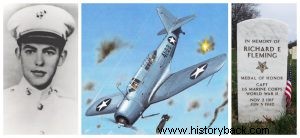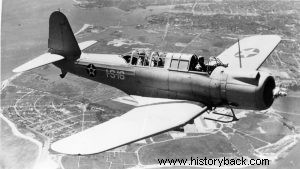
Captain Richard Eugene Fleming was born in 1917. He graduated from the military academy and then studied Fine Arts. In 1939 he trained as a pilot joining the Marine Corps Reserve. He graduated with a pilot's license in 1940.
After Pearl Harbor he was sent to the Pacific. On June 4, 1942 he was at Midway attached to the 241st Marine Bombardment Squadron. The squadron had Vought SB2U Vindicator vertical attack aircraft.
That day the squadron attacked Japanese ships. Her commander was killed and Fleming took command. He attacked alone from a height of only 120m. to strike a blow by miraculously surviving. The next day American planes were in the air again. Fleming spotted the Japanese heavy cruiser Mikuma and attacked it.
Flying at a very low altitude he attacked but the bomb he was carrying exploded very close to the Japanese vessel causing damage to it. His aircraft was hit by anti-aircraft fire and crashed into the sea. Himself and Lt. George Albert Tom's machine gunner were killed.
However, eyewitnesses, both American and Japanese, narrate the fate of the two Americans differently. According to the testimonies, Fleming hit the Japanese cruiser with his bomb and then dropped his stricken aircraft on one of the ship's main gun turrets. They argue that this is also inferred from the famous photograph depicting the Japanese vessel shortly before it sank.
“The American pilot (Fleming) after being hit by anti-aircraft fire, bravely attempted to crash on the bridge of the cruiser. It did not make it but crashed into the gun turret causing a fire which spread to the rear engine room resulting in an explosion which killed everyone in the engine room. It was the fatal blow to the cruiser", report the Japanese Mitsuo Fuchida and Masatake Okumiya.
Some other sources, however, attribute the explosion in the cruiser to the detonation of the torpedoes in its torpedo tubes.



The Japanese cruiser Mikuma, just before it sank.
